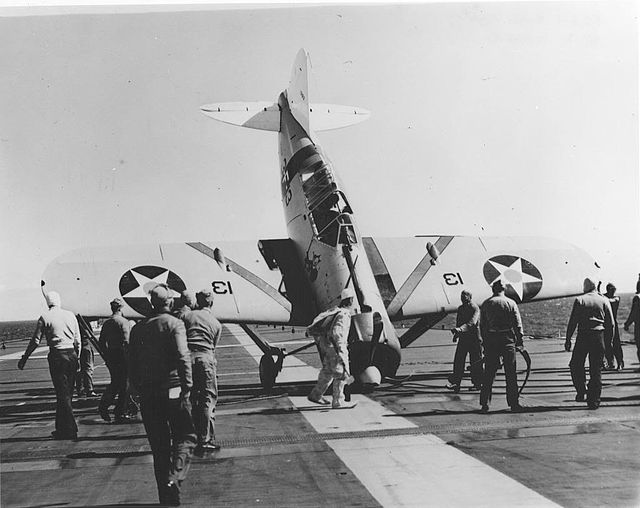Marine Fighting Squadron 221 (VMF-221) was a reserve fighter squadron of the United States Marine Corps. Originally commissioned during the World War II, it flew the Brewster F2A-3, and after reconstitution in 1943, the F4U Corsair. The squadron, also known as the "Fighting Falcons", is most notable for its actions on 4 June 1942, during the Battle of Midway, which resulted in 23 members of the squadron, many posthumously, being awarded the Navy Cross for their actions in combat. VMF-221 ended World War II with 185 air-to-air victories, the second most of any Marine Fighting Squadron in the war.
A VMF-221 F2A-3 in flight over NAS North Island, October 1941.
Survivors of the Battle of Midway at Ewa Mooring Mast Field, Oahu on 22 June 1942. From left to right: Capt Marion E. Carl, Capt Kirk Armistead, Maj Raymond Scollin (of Marine Air Group 22), Capt Herbert T. Merrill, 2nd Lt Charles M. Kunz, 2nd Lt Charles S. Hughes, 2nd Lt Hyde Phillips, Capt Philip R. White, and 2nd Lt Roy A. Corry, Jr.
1st Lt. James E. Swett, with other members of his VMF-221 squadron, describing his Medal of Honor actions.
The Brewster F2A Buffalo is an American fighter aircraft which saw service early in World War II. Designed and built by the Brewster Aeronautical Corporation, it was one of the first U.S. monoplanes with an arrestor hook and other modifications for aircraft carriers. The Buffalo won a competition against the Grumman F4F Wildcat in 1939 to become the U.S. Navy's first monoplane fighter aircraft. Although superior to the Grumman F3F biplane it replaced, and the early F4Fs, the Buffalo was largely obsolete when the United States entered the war, being unstable and overweight, especially when compared to the Japanese Mitsubishi A6M Zero.
Brewster F2A Buffalo
Brewster XF2A-1 prototype
LT John S. Thach tipped this F2A-1 onto its nose on Saratoga, March 1940
F2A-3s serving as U.S. Navy training aircraft at NAS Miami, 1942–1943







